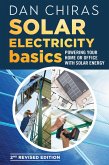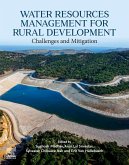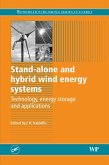22,95 €
22,95 €
inkl. MwSt.
Sofort per Download lieferbar

11 °P sammeln
22,95 €
Als Download kaufen

22,95 €
inkl. MwSt.
Sofort per Download lieferbar

11 °P sammeln
Jetzt verschenken
Alle Infos zum eBook verschenken
22,95 €
inkl. MwSt.
Sofort per Download lieferbar
Alle Infos zum eBook verschenken

11 °P sammeln
- Format: ePub
- Merkliste
- Auf die Merkliste
- Bewerten Bewerten
- Teilen
- Produkt teilen
- Produkterinnerung
- Produkterinnerung

Bitte loggen Sie sich zunächst in Ihr Kundenkonto ein oder registrieren Sie sich bei
bücher.de, um das eBook-Abo tolino select nutzen zu können.
Hier können Sie sich einloggen
Hier können Sie sich einloggen
Sie sind bereits eingeloggt. Klicken Sie auf 2. tolino select Abo, um fortzufahren.

Bitte loggen Sie sich zunächst in Ihr Kundenkonto ein oder registrieren Sie sich bei bücher.de, um das eBook-Abo tolino select nutzen zu können.
Microhydro features the smallest version of the renewable engery technology dubbed the simplest, most reliable and least expensive way to generate power off grid. Highly illustrated and practical, it is a complete guide to designing and constructing reliable hydroelectric power systems.
- Geräte: eReader
- ohne Kopierschutz
- eBook Hilfe
- Größe: 4.78MB
Andere Kunden interessierten sich auch für
![Real Goods Solar Living Sourcebook (eBook, ePUB) Real Goods Solar Living Sourcebook (eBook, ePUB)]() John SchaefferReal Goods Solar Living Sourcebook (eBook, ePUB)13,95 €
John SchaefferReal Goods Solar Living Sourcebook (eBook, ePUB)13,95 €![Solar Electricity Basics (eBook, ePUB) Solar Electricity Basics (eBook, ePUB)]() Dan ChirasSolar Electricity Basics (eBook, ePUB)13,95 €
Dan ChirasSolar Electricity Basics (eBook, ePUB)13,95 €![Water Resources Management for Rural Development (eBook, ePUB) Water Resources Management for Rural Development (eBook, ePUB)]() Water Resources Management for Rural Development (eBook, ePUB)95,95 €
Water Resources Management for Rural Development (eBook, ePUB)95,95 €![Solar Energy in Buildings (eBook, ePUB) Solar Energy in Buildings (eBook, ePUB)]() Dorota ChwiedukSolar Energy in Buildings (eBook, ePUB)71,95 €
Dorota ChwiedukSolar Energy in Buildings (eBook, ePUB)71,95 €![Geofluids (eBook, ePUB) Geofluids (eBook, ePUB)]() Vratislav HuraiGeofluids (eBook, ePUB)84,95 €
Vratislav HuraiGeofluids (eBook, ePUB)84,95 €![Wood Pellet Heating Systems (eBook, ePUB) Wood Pellet Heating Systems (eBook, ePUB)]() Dilwyn JenkinsWood Pellet Heating Systems (eBook, ePUB)38,95 €
Dilwyn JenkinsWood Pellet Heating Systems (eBook, ePUB)38,95 €![Stand-Alone and Hybrid Wind Energy Systems (eBook, ePUB) Stand-Alone and Hybrid Wind Energy Systems (eBook, ePUB)]() Stand-Alone and Hybrid Wind Energy Systems (eBook, ePUB)164,95 €
Stand-Alone and Hybrid Wind Energy Systems (eBook, ePUB)164,95 €-
-
-
Microhydro features the smallest version of the renewable engery technology dubbed the simplest, most reliable and least expensive way to generate power off grid. Highly illustrated and practical, it is a complete guide to designing and constructing reliable hydroelectric power systems.
Produktdetails
- Produktdetails
- Verlag: New Society Publishers
- Seitenzahl: 177
- Erscheinungstermin: 16. Mai 2023
- Englisch
- ISBN-13: 9781550923988
- Artikelnr.: 38323040
- Verlag: New Society Publishers
- Seitenzahl: 177
- Erscheinungstermin: 16. Mai 2023
- Englisch
- ISBN-13: 9781550923988
- Artikelnr.: 38323040
- Herstellerkennzeichnung Die Herstellerinformationen sind derzeit nicht verfügbar.
Scott Davis is an award-winning renewable energy project developer with decades of experience operating, installing, designing, selling and teaching about microhydro technology. He is a founder and president of Friends of Renewable Energy BC, and the author of two books on microhydro.
Dedication
Acknowledgments
Introduction
1 What is Microhydro?
Introducing Electricity and Hydraulics
About DC
About AC
Moving Power
Electricity and Water
Calculating Electrical Characteristics
Hydroelectricity
Focus on Microhydro
Good News, Bad News
2 Assessing Your Energy Needs
The Kilowatt Hour
Electrical Consumption and Capacity
Comparing Service from Different Technologies
Rating Photovoltaic Outputs
Rating Wind Outputs
Rating Microhydro Outputs
Different Jobs - Different Power Requirements
Assessing Your Requirements, Assessing Your Site
How Much and What Type of Power do you Need?
Assessing Your Consumption
The Consumption Self-Rating Scale
How Much Power Do You Need?
Interpreting Your Score
Introducing the Capacity Self-rating Scale
The Capacity Self-rating Scale
Off-grid and Needing Some Power
How Much is Enough?
Do You Need Power in the Winter?
If You Need Just a Bit of Power
If You Live There Full-time
The Magic Number
Getting Even More Performance from Your System
3 Assessing Your Site
Step 1: Measuring Stream Flow
Estimating Flow Rate
The Container Method
The Weir Method
Step 2: Measuring Pressure
Using a Pressure Gauge
Converting Pressure into Head
Measuring Maximum Flow Rate
Surveying
Using a Water Level
Go Figure!
Step 3: Creating a Stream Profile
Calculating Potential Output
Step 4: Calculating Allowable Frictional Loss Rate
Go Figure!
Step 5: Finding Optimum Flow Rate
Go Figure!
Step 6: Calculating Power Output
Choosing Jets
Go Figure!
4 The Appropriate System for You
Battery Charging Systems
Batteries in Microhydro
Charging Batteries
Charge Control
Producing AC from Batteries with an Intverter
Alternators
Turbines
Impulse Turbines for High Head
Low Head Turbines
Low Head AC Turbines
Other Turbine Solutions
Constructing your own Turbine
Balance of System Equipment
Batteries
Battery Charge Control
Diversion Loads
Inverters
Small AC Systems
Governing Small AC Systems
More Early Practices
Modern Solutions
AC Systems
Efficiency
Governing Larger AC Systems
AC Turbines
Belt Drives
Low Head, Multiple-kilowatt AC
Transmitting AC Power
5 Getting Started
About Pipe
Polyethylene (Poly)
PVC
Sizing Pipe
Low Pressure and High Pressure Pipe
Microhydro Opportunities
Spring Water
Existing Pipes
Low Head Systems
Microhydro Obstacles
Very Steep Ground
Waterfalls
Debris
High Water, Low Water
Freezing Weather
Ice
Installing Microhydro Equipment
Penstocks
Plumbing
Valves
Pressure Gauge
Vaccuum Breaker
Plumbing in the Powerhouse
Intakes
6 Regulations and Incentives
The Carrot: Government Incentives for Microhydro
Appropriate Incentives for Appropriate Technology
Incentives in Canada
Incentives in the United States
The Stick: Regulations
The Process in British Columbia
Department of Fisheries and Oceans
Department of Water, Land and Air Protection
7 Case Studies
Case Study 1: A System with a Long Pipeline
The Problem
The Solution
Replacing this System Today
Case Study 2: A System with a Long Transmission Line
The Problem
The Solution
Replacing this System Today
Case Study 3: A Simple System
The Problem
The Solution
Replacing this System Today
Case Study 4: A Small AC System
The Problem
The Solution
Case Study 5: Upgrading a Small AC System
The Problem
The Solution
Replacing this System Today
Case Study 6: A Low-head AC System
The Problem
The Solution
Case Study 7: A Relatively High-output System
The Problem
The Solution
Replacing this System Today
Glossary
Resources
Index
About the Author
Acknowledgments
Introduction
1 What is Microhydro?
Introducing Electricity and Hydraulics
About DC
About AC
Moving Power
Electricity and Water
Calculating Electrical Characteristics
Hydroelectricity
Focus on Microhydro
Good News, Bad News
2 Assessing Your Energy Needs
The Kilowatt Hour
Electrical Consumption and Capacity
Comparing Service from Different Technologies
Rating Photovoltaic Outputs
Rating Wind Outputs
Rating Microhydro Outputs
Different Jobs - Different Power Requirements
Assessing Your Requirements, Assessing Your Site
How Much and What Type of Power do you Need?
Assessing Your Consumption
The Consumption Self-Rating Scale
How Much Power Do You Need?
Interpreting Your Score
Introducing the Capacity Self-rating Scale
The Capacity Self-rating Scale
Off-grid and Needing Some Power
How Much is Enough?
Do You Need Power in the Winter?
If You Need Just a Bit of Power
If You Live There Full-time
The Magic Number
Getting Even More Performance from Your System
3 Assessing Your Site
Step 1: Measuring Stream Flow
Estimating Flow Rate
The Container Method
The Weir Method
Step 2: Measuring Pressure
Using a Pressure Gauge
Converting Pressure into Head
Measuring Maximum Flow Rate
Surveying
Using a Water Level
Go Figure!
Step 3: Creating a Stream Profile
Calculating Potential Output
Step 4: Calculating Allowable Frictional Loss Rate
Go Figure!
Step 5: Finding Optimum Flow Rate
Go Figure!
Step 6: Calculating Power Output
Choosing Jets
Go Figure!
4 The Appropriate System for You
Battery Charging Systems
Batteries in Microhydro
Charging Batteries
Charge Control
Producing AC from Batteries with an Intverter
Alternators
Turbines
Impulse Turbines for High Head
Low Head Turbines
Low Head AC Turbines
Other Turbine Solutions
Constructing your own Turbine
Balance of System Equipment
Batteries
Battery Charge Control
Diversion Loads
Inverters
Small AC Systems
Governing Small AC Systems
More Early Practices
Modern Solutions
AC Systems
Efficiency
Governing Larger AC Systems
AC Turbines
Belt Drives
Low Head, Multiple-kilowatt AC
Transmitting AC Power
5 Getting Started
About Pipe
Polyethylene (Poly)
PVC
Sizing Pipe
Low Pressure and High Pressure Pipe
Microhydro Opportunities
Spring Water
Existing Pipes
Low Head Systems
Microhydro Obstacles
Very Steep Ground
Waterfalls
Debris
High Water, Low Water
Freezing Weather
Ice
Installing Microhydro Equipment
Penstocks
Plumbing
Valves
Pressure Gauge
Vaccuum Breaker
Plumbing in the Powerhouse
Intakes
6 Regulations and Incentives
The Carrot: Government Incentives for Microhydro
Appropriate Incentives for Appropriate Technology
Incentives in Canada
Incentives in the United States
The Stick: Regulations
The Process in British Columbia
Department of Fisheries and Oceans
Department of Water, Land and Air Protection
7 Case Studies
Case Study 1: A System with a Long Pipeline
The Problem
The Solution
Replacing this System Today
Case Study 2: A System with a Long Transmission Line
The Problem
The Solution
Replacing this System Today
Case Study 3: A Simple System
The Problem
The Solution
Replacing this System Today
Case Study 4: A Small AC System
The Problem
The Solution
Case Study 5: Upgrading a Small AC System
The Problem
The Solution
Replacing this System Today
Case Study 6: A Low-head AC System
The Problem
The Solution
Case Study 7: A Relatively High-output System
The Problem
The Solution
Replacing this System Today
Glossary
Resources
Index
About the Author
Dedication
Acknowledgments
Introduction
1 What is Microhydro?
Introducing Electricity and Hydraulics
About DC
About AC
Moving Power
Electricity and Water
Calculating Electrical Characteristics
Hydroelectricity
Focus on Microhydro
Good News, Bad News
2 Assessing Your Energy Needs
The Kilowatt Hour
Electrical Consumption and Capacity
Comparing Service from Different Technologies
Rating Photovoltaic Outputs
Rating Wind Outputs
Rating Microhydro Outputs
Different Jobs - Different Power Requirements
Assessing Your Requirements, Assessing Your Site
How Much and What Type of Power do you Need?
Assessing Your Consumption
The Consumption Self-Rating Scale
How Much Power Do You Need?
Interpreting Your Score
Introducing the Capacity Self-rating Scale
The Capacity Self-rating Scale
Off-grid and Needing Some Power
How Much is Enough?
Do You Need Power in the Winter?
If You Need Just a Bit of Power
If You Live There Full-time
The Magic Number
Getting Even More Performance from Your System
3 Assessing Your Site
Step 1: Measuring Stream Flow
Estimating Flow Rate
The Container Method
The Weir Method
Step 2: Measuring Pressure
Using a Pressure Gauge
Converting Pressure into Head
Measuring Maximum Flow Rate
Surveying
Using a Water Level
Go Figure!
Step 3: Creating a Stream Profile
Calculating Potential Output
Step 4: Calculating Allowable Frictional Loss Rate
Go Figure!
Step 5: Finding Optimum Flow Rate
Go Figure!
Step 6: Calculating Power Output
Choosing Jets
Go Figure!
4 The Appropriate System for You
Battery Charging Systems
Batteries in Microhydro
Charging Batteries
Charge Control
Producing AC from Batteries with an Intverter
Alternators
Turbines
Impulse Turbines for High Head
Low Head Turbines
Low Head AC Turbines
Other Turbine Solutions
Constructing your own Turbine
Balance of System Equipment
Batteries
Battery Charge Control
Diversion Loads
Inverters
Small AC Systems
Governing Small AC Systems
More Early Practices
Modern Solutions
AC Systems
Efficiency
Governing Larger AC Systems
AC Turbines
Belt Drives
Low Head, Multiple-kilowatt AC
Transmitting AC Power
5 Getting Started
About Pipe
Polyethylene (Poly)
PVC
Sizing Pipe
Low Pressure and High Pressure Pipe
Microhydro Opportunities
Spring Water
Existing Pipes
Low Head Systems
Microhydro Obstacles
Very Steep Ground
Waterfalls
Debris
High Water, Low Water
Freezing Weather
Ice
Installing Microhydro Equipment
Penstocks
Plumbing
Valves
Pressure Gauge
Vaccuum Breaker
Plumbing in the Powerhouse
Intakes
6 Regulations and Incentives
The Carrot: Government Incentives for Microhydro
Appropriate Incentives for Appropriate Technology
Incentives in Canada
Incentives in the United States
The Stick: Regulations
The Process in British Columbia
Department of Fisheries and Oceans
Department of Water, Land and Air Protection
7 Case Studies
Case Study 1: A System with a Long Pipeline
The Problem
The Solution
Replacing this System Today
Case Study 2: A System with a Long Transmission Line
The Problem
The Solution
Replacing this System Today
Case Study 3: A Simple System
The Problem
The Solution
Replacing this System Today
Case Study 4: A Small AC System
The Problem
The Solution
Case Study 5: Upgrading a Small AC System
The Problem
The Solution
Replacing this System Today
Case Study 6: A Low-head AC System
The Problem
The Solution
Case Study 7: A Relatively High-output System
The Problem
The Solution
Replacing this System Today
Glossary
Resources
Index
About the Author
Acknowledgments
Introduction
1 What is Microhydro?
Introducing Electricity and Hydraulics
About DC
About AC
Moving Power
Electricity and Water
Calculating Electrical Characteristics
Hydroelectricity
Focus on Microhydro
Good News, Bad News
2 Assessing Your Energy Needs
The Kilowatt Hour
Electrical Consumption and Capacity
Comparing Service from Different Technologies
Rating Photovoltaic Outputs
Rating Wind Outputs
Rating Microhydro Outputs
Different Jobs - Different Power Requirements
Assessing Your Requirements, Assessing Your Site
How Much and What Type of Power do you Need?
Assessing Your Consumption
The Consumption Self-Rating Scale
How Much Power Do You Need?
Interpreting Your Score
Introducing the Capacity Self-rating Scale
The Capacity Self-rating Scale
Off-grid and Needing Some Power
How Much is Enough?
Do You Need Power in the Winter?
If You Need Just a Bit of Power
If You Live There Full-time
The Magic Number
Getting Even More Performance from Your System
3 Assessing Your Site
Step 1: Measuring Stream Flow
Estimating Flow Rate
The Container Method
The Weir Method
Step 2: Measuring Pressure
Using a Pressure Gauge
Converting Pressure into Head
Measuring Maximum Flow Rate
Surveying
Using a Water Level
Go Figure!
Step 3: Creating a Stream Profile
Calculating Potential Output
Step 4: Calculating Allowable Frictional Loss Rate
Go Figure!
Step 5: Finding Optimum Flow Rate
Go Figure!
Step 6: Calculating Power Output
Choosing Jets
Go Figure!
4 The Appropriate System for You
Battery Charging Systems
Batteries in Microhydro
Charging Batteries
Charge Control
Producing AC from Batteries with an Intverter
Alternators
Turbines
Impulse Turbines for High Head
Low Head Turbines
Low Head AC Turbines
Other Turbine Solutions
Constructing your own Turbine
Balance of System Equipment
Batteries
Battery Charge Control
Diversion Loads
Inverters
Small AC Systems
Governing Small AC Systems
More Early Practices
Modern Solutions
AC Systems
Efficiency
Governing Larger AC Systems
AC Turbines
Belt Drives
Low Head, Multiple-kilowatt AC
Transmitting AC Power
5 Getting Started
About Pipe
Polyethylene (Poly)
PVC
Sizing Pipe
Low Pressure and High Pressure Pipe
Microhydro Opportunities
Spring Water
Existing Pipes
Low Head Systems
Microhydro Obstacles
Very Steep Ground
Waterfalls
Debris
High Water, Low Water
Freezing Weather
Ice
Installing Microhydro Equipment
Penstocks
Plumbing
Valves
Pressure Gauge
Vaccuum Breaker
Plumbing in the Powerhouse
Intakes
6 Regulations and Incentives
The Carrot: Government Incentives for Microhydro
Appropriate Incentives for Appropriate Technology
Incentives in Canada
Incentives in the United States
The Stick: Regulations
The Process in British Columbia
Department of Fisheries and Oceans
Department of Water, Land and Air Protection
7 Case Studies
Case Study 1: A System with a Long Pipeline
The Problem
The Solution
Replacing this System Today
Case Study 2: A System with a Long Transmission Line
The Problem
The Solution
Replacing this System Today
Case Study 3: A Simple System
The Problem
The Solution
Replacing this System Today
Case Study 4: A Small AC System
The Problem
The Solution
Case Study 5: Upgrading a Small AC System
The Problem
The Solution
Replacing this System Today
Case Study 6: A Low-head AC System
The Problem
The Solution
Case Study 7: A Relatively High-output System
The Problem
The Solution
Replacing this System Today
Glossary
Resources
Index
About the Author







